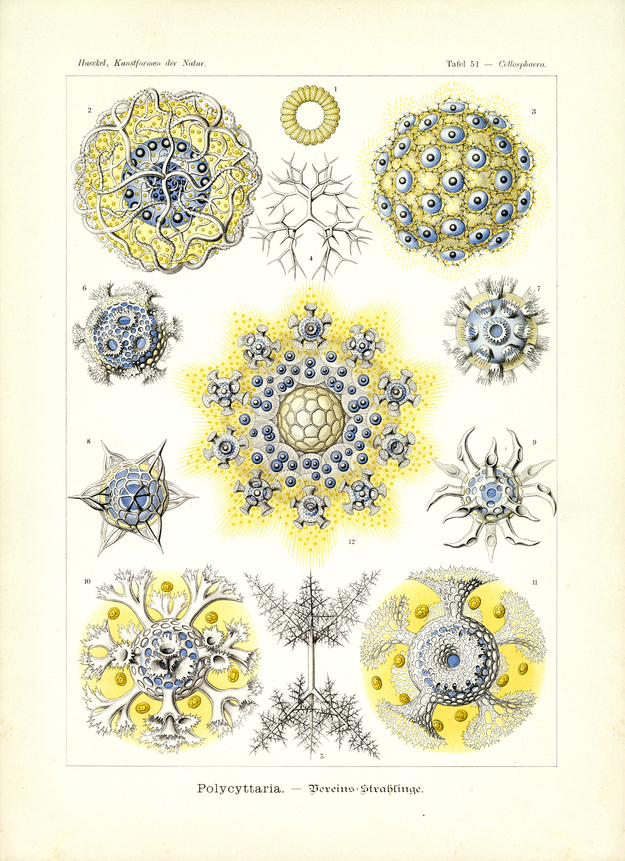The small order of “association radiants” or “social radiaolaria”, combined within the system under the heading Polycttaria, distinguishes itself from other Protozoa of this class by their tendency to associate (German: associon?). While the large majority of Radiolaria is represented by solitarily living “hermit-cells” (Eremobia, plate 1, 11, 21, 31, 41) Polycyttaria form lasting cell unions (Coenobia). The numerous convivial cells that present such a union or a “cell colony” possess a special central capsule each, covered by a strong membrane, with the nucleus in its centre (in old age a ‘fatty pellet’ replaces the nucleus). The soft Calymma, the gelatinous cover, is common to all with the central capsules embedded in it. The gelatinous mass is usually filled with water bubbles or Vacuoles; at times one bigger nodular central bubble is of a special kind (fig. 12) The innumerable plasma threads that emanate from the individual central capsules branch off and coalesce inside the Calymma to form a dense network; at the upper surface, however, they spread in the form of delicate, radial tentacles. Numerous yellow cells lying scattered in between the capsules in the Calymma do not belong to the colony itself; they are unicellular plants (Algariae) of the kind Xanthella; they live in symbiosis with Radiolaria (association for mutual benefit, fig. 2, 10, 11, 12).
Polycyttaria belong to the legion of Spumellaria (due to the structure of their central capsule) and form a special order within this legion. It comprises three families: I. Collozoida, not forming a lime skeleton, II. Sphaerozoida with a lime skeleton that consists of many individual lime pieces in needle-shape that are spread in a loose and scattered way in the Calymma (fig. 2-5); III. Collosphaerida with each individual central capsule being covered with a grilled lime shell (fig. 6-12).
Translation of the original German introduction by Ernst Haeckel:
Phylum of Protozoa (Urtiere); - main class of Rhizopoda (Wurzelfüßer); - class of Radiolaria (Strahlinge); - legion of Peripyleen or Spumellaria (Schaumsternchen); - order of Polycyttaria (Vereins-Strahlinge).
Translation by VR Translators Bangalore
This is one of the 100 pop science biology illustrations that were published from 1899 – 1904 in Leipzig by Ernst Haeckel through Verlag des Bibliographischen Instituts.
We've scanned the original lithography at 1200dpi on the Epson A3 scanner of A3 scanner huren. You can download a 400dpi JPEG here.
